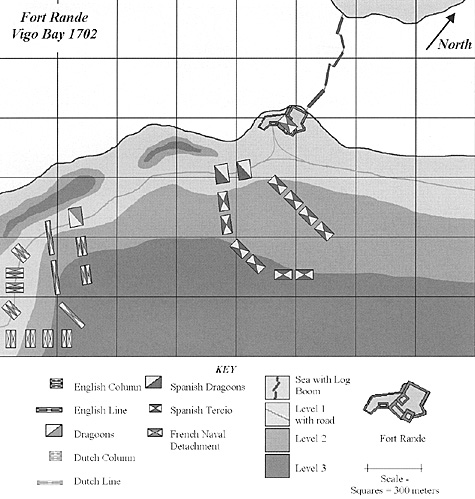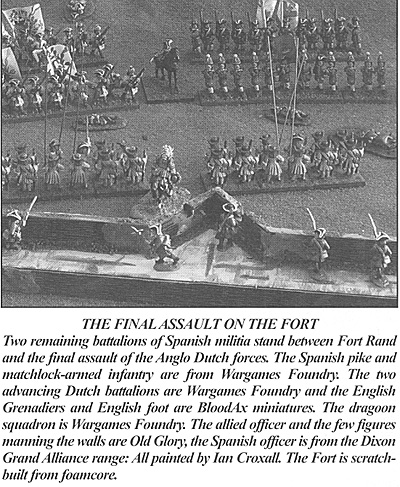 The Ground
The Ground
The game board map has been constructed from a modern 1:25,000 topographical map with the site of the fort, now in ruins, confirmed by a local resident of the region. The hills south and east are fairly steep and if in true height scale would requite another one or two contour levels in the lower row of squares on the map. For gaming purposes it is not necessary to show these and all level three contours should be considered steep hills and all movement penalized while on level thee. The two hills by the beach are very steep and impassable. Any level two contour is to be considered steep at any point that it is less than six inches deep.
The road is a minor track and does not impart any movement advantage.
The southern hook section of the fort (see plan below) is the gun platform and its walls are low enough that troops can scale it, but this wall should nevertheless provide significant defensive advantage using your rules’ heavy fortifications modifier. However, if your rules do not provide for it, the converged grenadiers should be given an assault bonus for the use of their grenades when assaulting the wall.
Burchett makes a passing reference to “entrenchments” and it is not certain if this references a line of fortifications other than its main walls, or if this is just an adjective for the fort. No entrenchments have been used in this game.
The Forces
Franco Spanish: The precise number of Spanish Militia involved has to be speculated. None of the primary English or Spanish accounts that I’ve found gives the names of the Spanish regiments involved. Spanish records indicate that there were some 10,000 provincial militia in the region but it is unlikely that all were involved. Prince de Brabançon, Governor of Galicia attended at the battle according to the eye witness accounts. The provincial militia units were not all uniformed, were probably not reliably armed at this early stage in the war, and in any event would still be using the matchlock. Infantry organization was still based on the tercio and included pike companies at the ratio of 1:4 pike to musket. Battalion’s strengths on paper were 600 men or so for the regular army, but were likely to be under-strength for provincial militia.
For this battle, I have assumed 10 battalions, each of which may represent 300-500 men. These should be based on the narrow frontage of five rank organizations and should have about half the frontage on an Anglo Dutch line unit which use 3-rank platoon firing tactics. The morale grade of the provincial militia should be the lowest grade that the rules allow. Their only formation is the line, and they may only advance and wheel. They should not be allowed any formation changes or maneuvers and should wheel at a penalty. They must fire if any target is in range and if your rules allow a bonus for first fire this should not be used as they are considered to have already fired ineffectually at long range. All Spanish units have plug bayonets.
The four squadrons of Spanish mounted are quasi-regular provincial militia and may best be handled as hussars or poorly trained regulars.
The unit in the fort is the 200-300 strong unit of French Marines and Sailors and a further 50 Spanish marines. This unit is of a more regular nature. In the fort, it may triple its frontage to line the walls and man the artillery. This unit is armed with muskets, socket bayonets or cutlasses and swords and is considered regular. It may sally from the fort and if it does so, the fort’s artillery may only fire at 1/4 strength if naval gunfire is being used. Anglo Dutch: These troops are better documented but not necessarily reliably so. The number of “English” varies from 2,500 to 5,000 or more. This may simply be a difference between writers referring just to the “English” (2,500) or to a combined number including the Dutch troops (5,000).
This game has been designed around those battalions described by Burchett as taking part in the landing. Each battalion should be considered to have a field strength of around 400 men. The English and Dutch line and Marine battalions should be counted as veteran troops, the grenadiers as crack and the Coldstream Guards as elite. Burchet described a detachment of 185 of Lloyd’s dragoons as being part of the Land Forces, but no one describes them in the battle. We have included a 2 squadron detachment in this game. They should be classed as veteran.
The Dutch battalions are not listed by regiment in any of the original accounts but the Dutch regiments assigned to the fleet expedition were St. Amand Marines, Swansbel Marines, van Pallandt, Lindeboom and Torsay. Both Burchett and R. Cannons history of the 2nd ‘Queens’ Regiment of foot says that the Dutch contingent at Vigo Bay was a little under 4000 men. However he does not quote battalion numbers and all 4000 could not have landed based on the witness accounts of the numbers of Anglo Dutch troops involved.
Deployment
As there are no contemporary drawings or map showing troop disposition, it has been necessary to speculate on troop deployment by comparing battle descriptions with 1:25000 topographical maps. This gives a high probability that the deployment shown is very similar to that described, and is at worst, a highly plausible alternative.
The plan of the fort is accurate, and is shown below for those who would like to construct an accurate model or to use for a skirmish style game.
The Anglo Dutch forces should either set up as indicated or should set up as desired in the six squares indicated, but not west of the road. The Spanish can be deployed as indicated, or may set up as desired - however, if a different set up is used, the Anglo-Dutch should set up first and then be hidden. The Spanish may then set up anywhere but no further south or southeast of the position shown on the deployment map.
The French unit must begin the game in the fort.
Victory Conditions
 Smashing Anglo-Dutch Victory: The Anglo-Dutch forces must take the fort in the number of game turns it would normally take a battalion in line to move 60”. For example, if your rules allow a battalion in line to advance 6” per turn in good going, then the Anglo-Dutch must take the fort in 10 turns.
Smashing Anglo-Dutch Victory: The Anglo-Dutch forces must take the fort in the number of game turns it would normally take a battalion in line to move 60”. For example, if your rules allow a battalion in line to advance 6” per turn in good going, then the Anglo-Dutch must take the fort in 10 turns.
The Final Assault on the Fort: Two remaining battalions of Spanish militia stand between Fort Rand and the final assault of the Anglo Dutch forces. The Spanish pike and matchlock-armed infantry are from Wargames Foundry. The two advancing Dutch battalions are Wargames Foundry and the English Grenadiers and English foot are BloodAx miniatures. The dragoon squadron is Wargames Foundry. The allied officer and the few figures manning the walls are Old Glory, the Spanish officer is from the Dixon Grand Alliance range: All painted by Ian Croxall. The Fort is scratch-built from foamcore.
If only the lower platform is taken in this number of turns, then it is a Partial Victory.
Partial Anglo-Dutch Victory: If it takes the Anglo-Dutch half as may turns again (15 turns in the above example) to take the fort, it is assume the artillery batteries have done significant damage to the Anglo-Dutch fleet before they were silenced.
Draw: If only the lower platform is captured, then the game is a Draw.
Franco Spanish Victory: The French and Spanish gain a victory if they avoid the Anglo-Dutch victory conditions. If ether the Guards or the Grenadiers are destroyed or broke AND the fort stays entirely in Franco-Spanish possession, then it is a Smashing Franco-Spanish Victory.
Variations
Naval Power: Using suitable naval rules, incorporate an English Man of War, which enters the map anywhere on the southwestern edge on turn one. It moves at the same speed as a line movement. Place a Spanish Man of War parallel to the boom. Fort Rande has a 38-gun Broadside and the fort just off the northwestern edge has a 17-gun broadside.
Skirmish: For those wishing to game the attack on the actual fort in more detail a model can be made of the fort based on this accurate plan view. In this version of the game, the fort, which is 120 meters at its widest point, can be garrisoned by five units of French, which will represent companies, and one unit of Spanish Marines. Eight units of Guards and eight units of Grenadiers can now make the assault. Each unit will represent a company.
Assault on Fort Rande: Historical Account
Back to Table of Contents -- Courier # 91
To Courier List of Issues
To MagWeb Master Magazine List
© Copyright 2004 by The Courier Publishing Company.
This article appears in MagWeb.com (Magazine Web) on the Internet World Wide Web.
Other articles from military history and related magazines are available at http://www.magweb.com